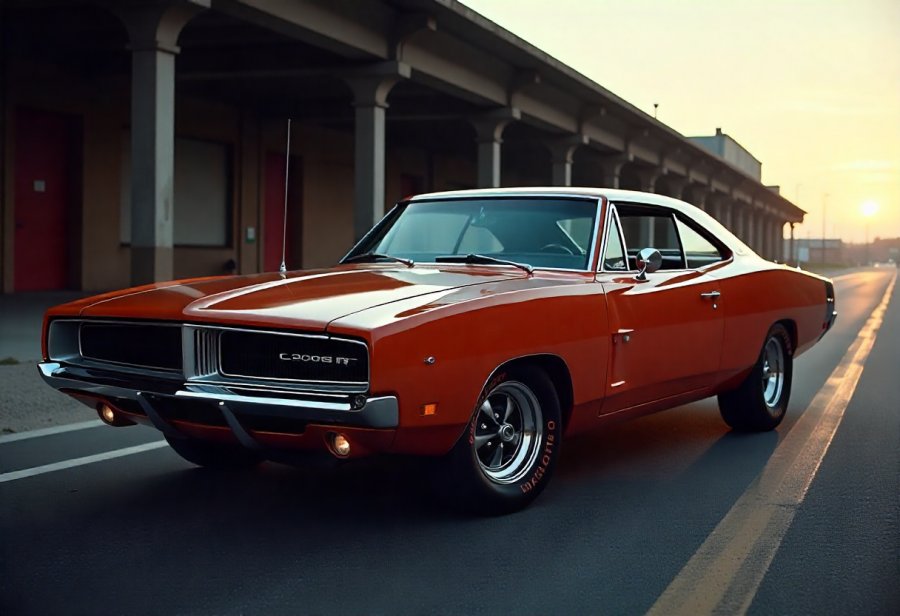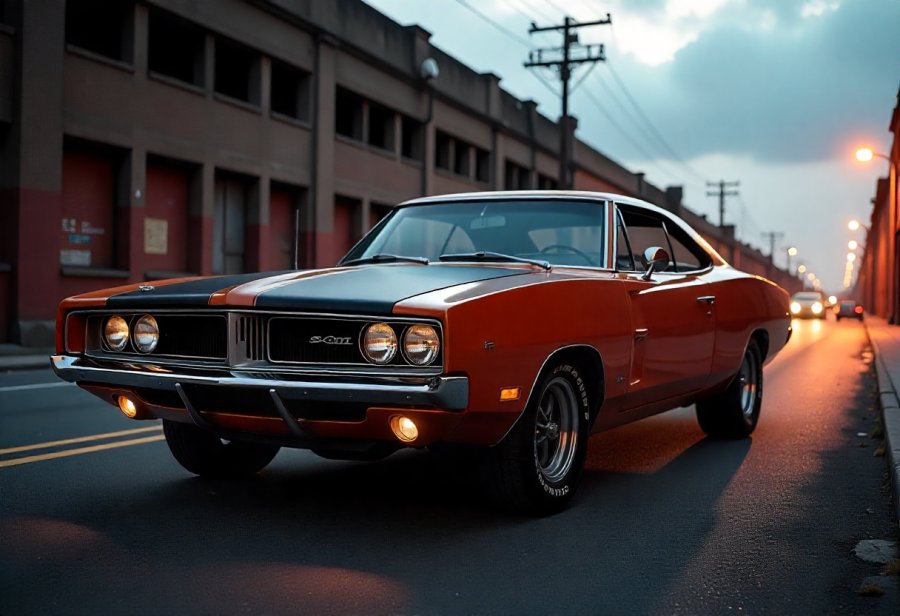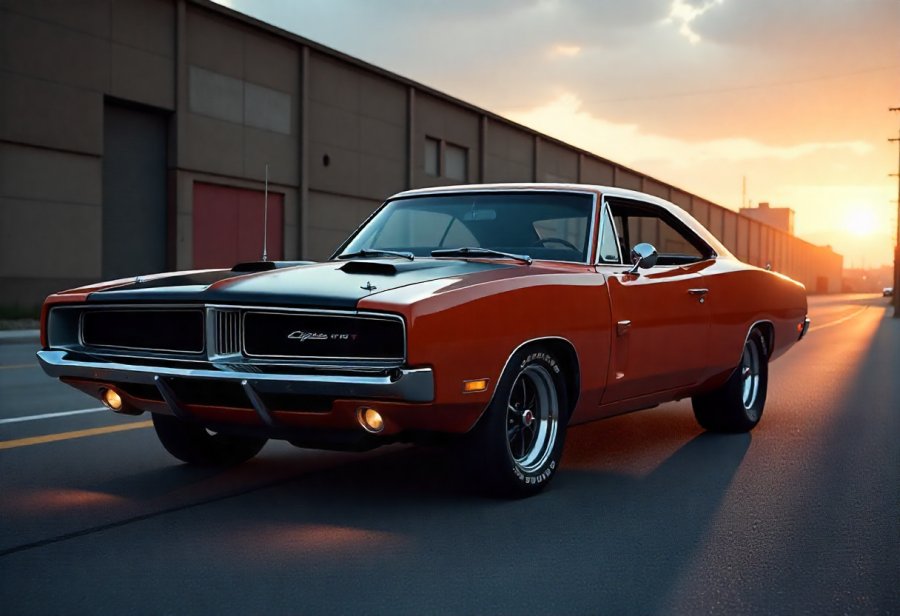
The Dodge Charger stands as an enduring symbol of American muscle and rebellious spirit, igniting primal instincts of speed, strength, and dominance. From its aggressive roots in the late 1960s to its modern iterations packed with advanced technology, this legendary vehicle embodies raw power and attitude. Its thunderous engine roars evoke deep-seated desires for control and adrenaline, making every drive a statement of independence. Yet, as the industry shifts toward electrification and greener solutions, can the Charger maintain its fierce, primal identity? Will future hybrid or electric models deliver the same visceral thrill without diluting its rebellious soul? This ongoing evolution challenges enthusiasts to reconcile tradition with innovation, ensuring the Charger’s legacy endures—an icon that continues to inspire awe, rebellion, and the relentless pursuit of power. How will this legendary muscle car reinvent itself while staying true to its primal essence?

Discover the Dodge Charger’s Iconic Rebellion and Raw Power
The Dodge Charger isn’t just a car; it’s a powerful symbol of American muscle and rebellious spirit. Since its debut in the late 1960s, the Charger has embodied more than just speed—it’s become an icon representing freedom, defiance, and raw, unfiltered power. Its bold design and roaring engine options have made it a staple in street scenes, movies, and popular culture, where it stands out as a true statement of attitude and independence.
From the moment it first appeared in 1966, the Charger’s distinctive silhouette set it apart from other vehicles. Its long, aggressive hood, sleek profile, and muscular stance immediately communicated performance and individuality. It was built not just to move quickly but to turn heads and make a statement. The bold styling cues—wide stance, prominent grille, and muscular lines—appealed to those craving excitement and a desire to stand out from the crowd.
Over the decades, the Charger’s reputation grew as a “rebellion on wheels,” closely linked to street racing and car culture. Its appearances in films, music, and street scenes reinforced its image as a symbol of independence and unrestrained power. The signature roar of its engines, along with its aggressive aesthetic, continues to evoke confidence and strength. More than just a vehicle, it’s a cultural icon that embodies the primal energy of American muscle cars.
Owning a Charger is about more than transportation; it’s about embracing a daring attitude. Whether cruising down the highway or tearing up the streets, the Charger encourages drivers to tap into their primal instincts—speed, control, and dominance. Its design and performance inspire a sense of freedom and rebellion, making every drive feel like a statement of independence. The Charger’s legacy is rooted in boldness, strength, and a relentless pursuit of raw power that continues to captivate enthusiasts and newcomers alike.
Trace the Bold Origins and Evolution of the Dodge Charger
The story of the Dodge Charger begins in 1966, when Dodge aimed to create a bold, performance-oriented muscle car that would stand out in a crowded market. Its design broke away from traditional sedans, featuring a long, muscular hood, sleek lines, and a wide stance that immediately signaled power and attitude. Early models packed big-block V8 engines, emphasizing raw horsepower and street credibility, appealing to drivers hungry for excitement and rebellion on the road.
As the late ‘60s and early ‘70s rolled in, the Charger evolved through several redesigns that reinforced its aggressive persona. The 1968 and 1969 models became legendary, thanks to their distinctive styling and high-performance trims like R/T and Daytona. These versions introduced wide front grilles, hood scoops, and racing stripes—visual cues that made it clear this was a car built for speed and street racing. Technological upgrades, such as better suspension and more efficient engines, pushed the boundaries of muscle car performance and further cemented its reputation.
The muscle car boom waned in the ‘70s, and tightening emissions regulations challenged the Charger’s dominance. Dodge responded with limited editions and performance variants, keeping the spirit alive despite industry shifts. The 1980s and ‘90s saw the model fade somewhat from the spotlight, but a loyal following and its reputation for raw, customizable power kept its legend alive among enthusiasts.
A major turning point came in 2006, when Dodge reintroduced the Charger with a modern design that paid homage to its roots. This new version combined contemporary styling with powerful engine options, including V8s and supercharged variants like the SRT Hellcat. The reimagined Charger balanced modern technology—advanced suspensions, digital displays, driver-assist features—with the primal appeal that defined its early years, quickly regaining its status as a street and drag strip favorite.
Each iteration since has refined performance and technology, ensuring the Charger remains relevant in today’s automotive landscape. Its evolution reflects a continuous effort to honor its rebellious legacy while adapting to changing standards and expectations. From its origins as a street racing icon to a modern muscle car that commands attention on the road, the Charger’s development is a testament to its enduring appeal and relentless pursuit of power.

Explore the Modern Dodge Charger: Power, Technology, and Style
The modern Dodge Charger continues to symbolize American muscle, blending its iconic past with cutting-edge technology and bold design. Today’s models are built for high performance, featuring powerful V8 engines like the 6.4-liter HEMI, which delivers over 370 horsepower, alongside the supercharged SRT Hellcat variants that exceed 700 horsepower. These cars aren’t just about raw power—they’re equipped with advanced suspension systems, adaptive traction control, and launch control, enabling lightning-fast acceleration and superior handling. Inside, drivers find modern touches like digital displays, infotainment systems, and driver-assist features, combining primal performance with contemporary convenience.
Visually, the latest Chargers maintain their aggressive stance, with sharp lines and a sculpted profile that pay homage to the muscle cars of yesteryear. The bold grille, wide stance, and muscular contours evoke strength and speed, making each model stand out on the road. Dodge’s design team ensures the Charger exudes confidence and primal road presence, reinforcing its reputation as a street racing icon in a modern package. This sleek, aerodynamic look not only enhances performance but also reinforces the car’s rebellious attitude.
Performance-wise, today’s Chargers are remarkably versatile, appealing to a broad range of drivers. High-performance trims come with upgraded brakes, sport-tuned suspensions, and specialized tires designed to maximize handling and acceleration. Whether for daily driving, spirited weekend rides, or drag racing, the Charger adapts without losing its core identity. This flexibility helps it stay relevant amid industry shifts toward electric vehicles, sparking debates about whether muscle cars can evolve without sacrificing their primal appeal.
Regionally, perceptions of the Charger vary. In the U.S., it remains a symbol of American muscle and rebellion, often customized with performance upgrades and bold paint schemes. Abroad, it’s appreciated more as a luxury muscle car—offering comfort and tech features while still echoing its street-racing roots. This broad appeal underscores the model’s ability to resonate across markets, all while staying true to its raw power and rebellious spirit.
As the automotive industry moves toward electrification, the Charger faces new challenges and opportunities. Manufacturers are exploring hybrid and electric variants that aim to deliver instant torque and blazing acceleration while meeting stricter emissions standards. Some enthusiasts worry electrification will dilute the primal roar that defines the Charger, but others see it as a chance to push performance into new, sustainable territory. High-performance electric models could redefine what muscle cars are capable of, blending power with eco-consciousness.
Despite these technological shifts, the Charger’s cultural significance endures. Its appearances in movies, music videos, and street scenes continue to reinforce its image as a symbol of rebellion and independence. For many owners, driving a Charger is about more than just transportation—it’s a statement of attitude and identity. As new generations discover the thrill of raw power, the Charger’s legacy as a modern muscle car remains strong, driven by its ability to adapt while preserving its primal essence.
For those interested in exploring the full range of features and the latest models, visiting the official Dodge website provides comprehensive information. Whether you’re looking to customize your own Charger or learn about available performance packages, the site offers detailed insights into what makes this muscle car a standout in its class. Discover more about the modern Dodge Charger and its evolution by checking out the latest updates at Dodge Charger.
Unleash the Primal Power and Cultural Iconography of the Dodge Charger
The Dodge Charger’s design and performance tap directly into our primal instincts of speed, strength, and dominance. Its thunderous engine isn’t just noise; it’s a growl that awakens a deep, visceral energy within. When that deep rumble reverberates through the chassis, it’s as if a beast is stirring—an audible reminder of the Charger’s connection to muscle car rebellion. This isn’t a vehicle built for subtlety but for making a statement, commanding attention with every rev and acceleration.
Its wide stance and aggressive lines evoke images of raw power ready to strike. Sculpted bodywork and a bold grille give the Charger a fierce presence that’s impossible to ignore. Every detail is a deliberate signal: this machine is designed to dominate the street, reflecting an unrestrained strength that’s both intimidating and captivating. The visual dominance isn’t accidental—it’s an embodiment of the core purpose: to assert control and embody unrelenting power.
Driving a Charger is about more than simply reaching a destination. It’s about connecting with a deep-seated desire for control and adrenaline. When you press the accelerator, you’re not just increasing speed—you’re unleashing an instinctual urge to conquer and own the road. The engine’s roar, the crackle of exhaust—these sounds stir something primal, awakening a sense of raw, unfiltered power that resonates on a fundamental level.
Culturally, the Charger amplifies its primal appeal through its iconic status in movies, music, and street racing scenes. It’s often portrayed as the ultimate symbol of rebellion and independence, a rolling emblem of American muscle. Its presence on screen and in real life reinforces the idea that owning a Charger isn’t just about performance; it’s a lifestyle rooted in defiance, freedom, and strength. Every appearance cements its role as a cultural icon embodying the spirit of unrestrained power.
Every element of the Charger, from its engine under the hood to its muscular profile, is crafted to evoke strength. The visceral sound of its engine, the tactile feel of the throttle, and the commanding stance all work together to forge an experience that appeals to our most basic instincts. It’s more than a mode of transport—it’s a declaration of independence, a celebration of primal road instincts that resonate with everyone who craves power.
For enthusiasts and everyday drivers alike, this primal power isn’t just a feeling; it’s an invitation to unleash the beast within. Customizations and tuning turn the Charger into an even more formidable street racing icon, amplifying its raw energy and pushing its limits. It’s about embracing that innate desire to dominate, to push beyond boundaries, and to experience the thrill of primal strength in its purest form.

Future Horizons: The Dodge Charger’s Legacy and Innovation Ahead
The Dodge Charger’s legacy as a symbol of raw power and rebellious spirit remains as strong as ever. Its bold design, thunderous engine options, and deep roots in American culture have cemented its place in automotive history. As the industry shifts toward greener technologies, the Charger faces the challenge—and opportunity—of evolving without losing its primal edge. Hybrid and electric variants are on the horizon, promising to deliver instant torque and blistering acceleration while aligning with modern environmental standards.
Looking ahead, Dodge must balance preserving the Charger’s iconic roar and aggressive stance with innovative advancements. Some enthusiasts worry that electrification might dilute the visceral experience that defines the name, but others see it as a chance to redefine muscle cars for a new era. High-performance electric models could unlock new levels of speed and handling, blending sustainability with the primal thrill of raw power. This evolution might just set a new standard for what a muscle car can be.
Regulatory pressures and stricter emissions laws will continue to shape its future development. Incorporating hybrid systems that offer both power and efficiency could become the norm, ensuring the Charger’s performance remains uncompromised. Advances in battery technology might extend range and responsiveness, allowing the Charger to stay relevant on the streets and in the hearts of its fans. The challenge will be in maintaining that signature presence—its growl, stance, and attitude—while embracing the technological change.
Despite these shifts, the Charger’s cultural impact endures. Its appearances in movies, music, and street scenes reinforce its image as an emblem of rebellion and independence. For many drivers, owning a Charger isn’t just about transportation; it’s a declaration of identity and attitude. As newer generations discover the thrill of unrestrained power, its legendary status is set to grow, fueled by a community passionate about customization and performance.
The community of enthusiasts and tuners will continue to shape its future, pushing boundaries and innovating ways to enhance raw power. Custom upgrades, performance mods, and shared passion keep the spirit alive, ensuring the Charger remains a canvas for personal expression. As long as drivers seek to unleash primal instincts—speed, control, and dominance—the Charger will thrive, evolving yet never losing its rebellious core.
In the end, the future of the Dodge Charger depends on its ability to adapt without sacrificing what makes it legendary. Its power, attitude, and rebellious soul are woven into every aspect of its identity. By embracing new technologies while honoring its roots, the Charger can continue to command attention on the streets and inspire new generations. It remains a resilient symbol of American muscle—ready to roar into the future while staying true to its uncompromising heritage.


